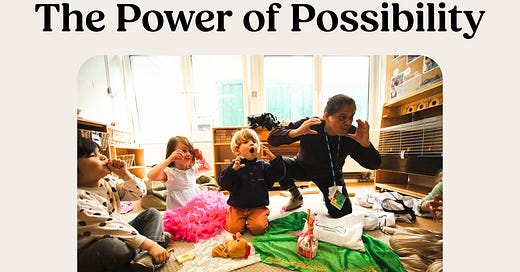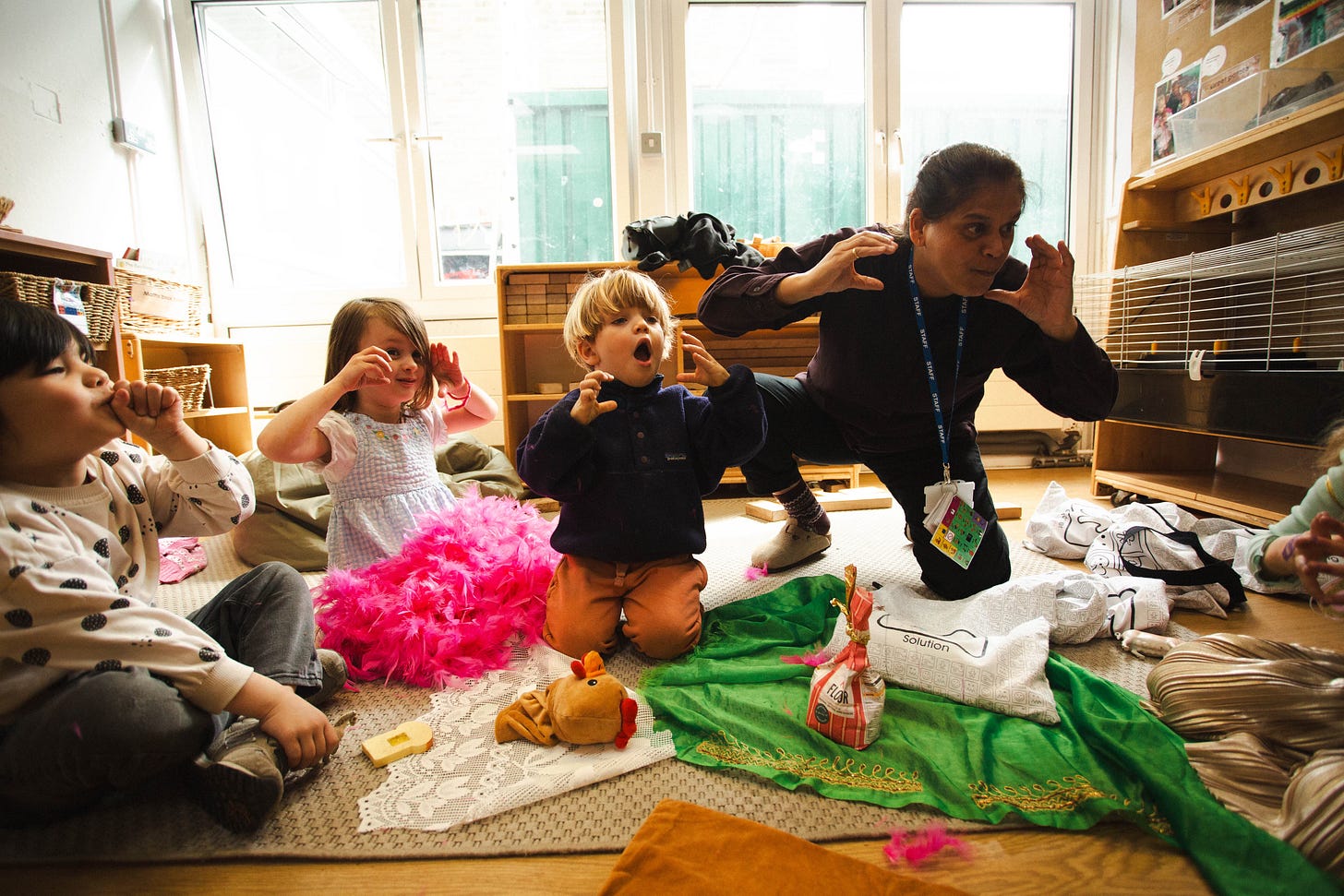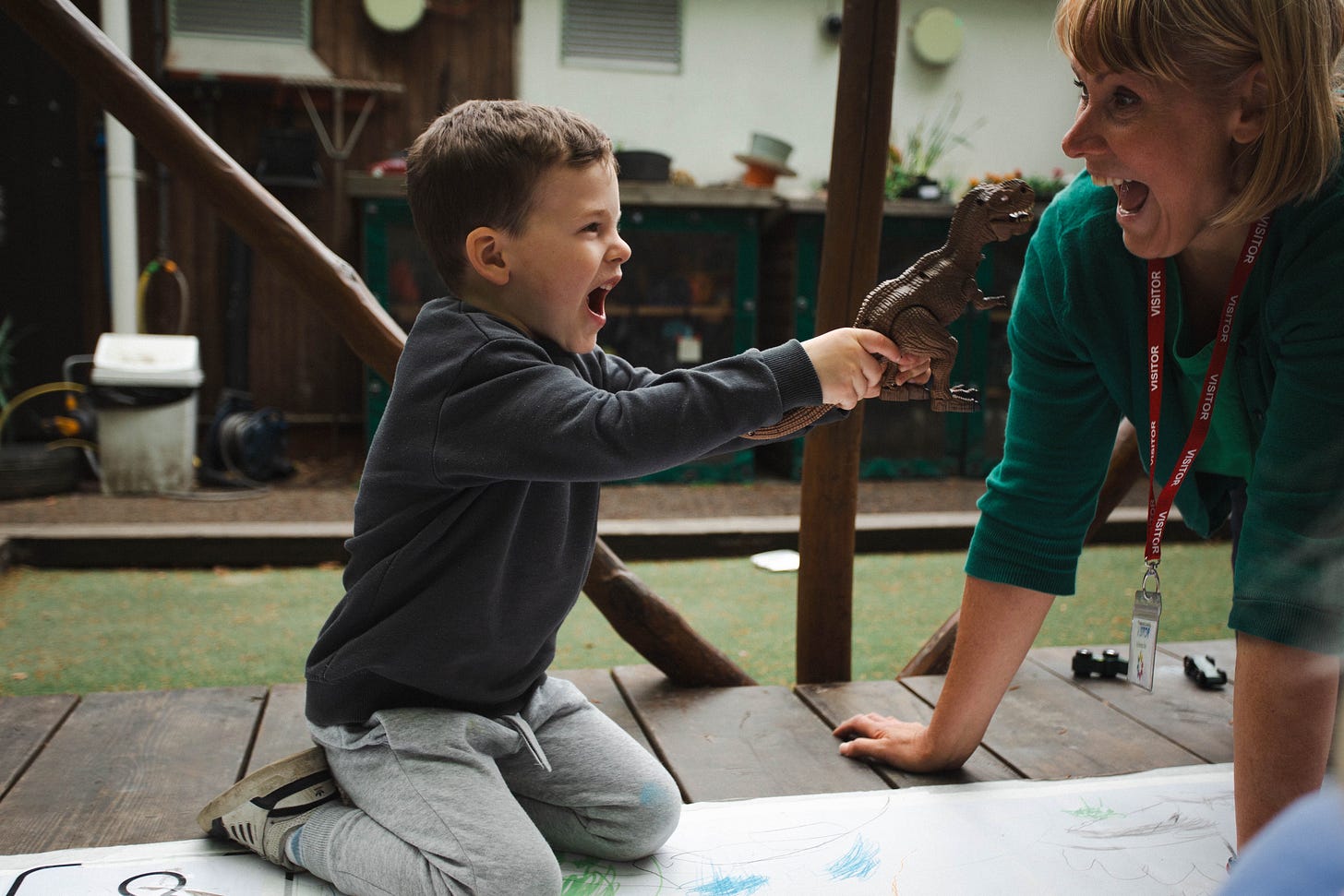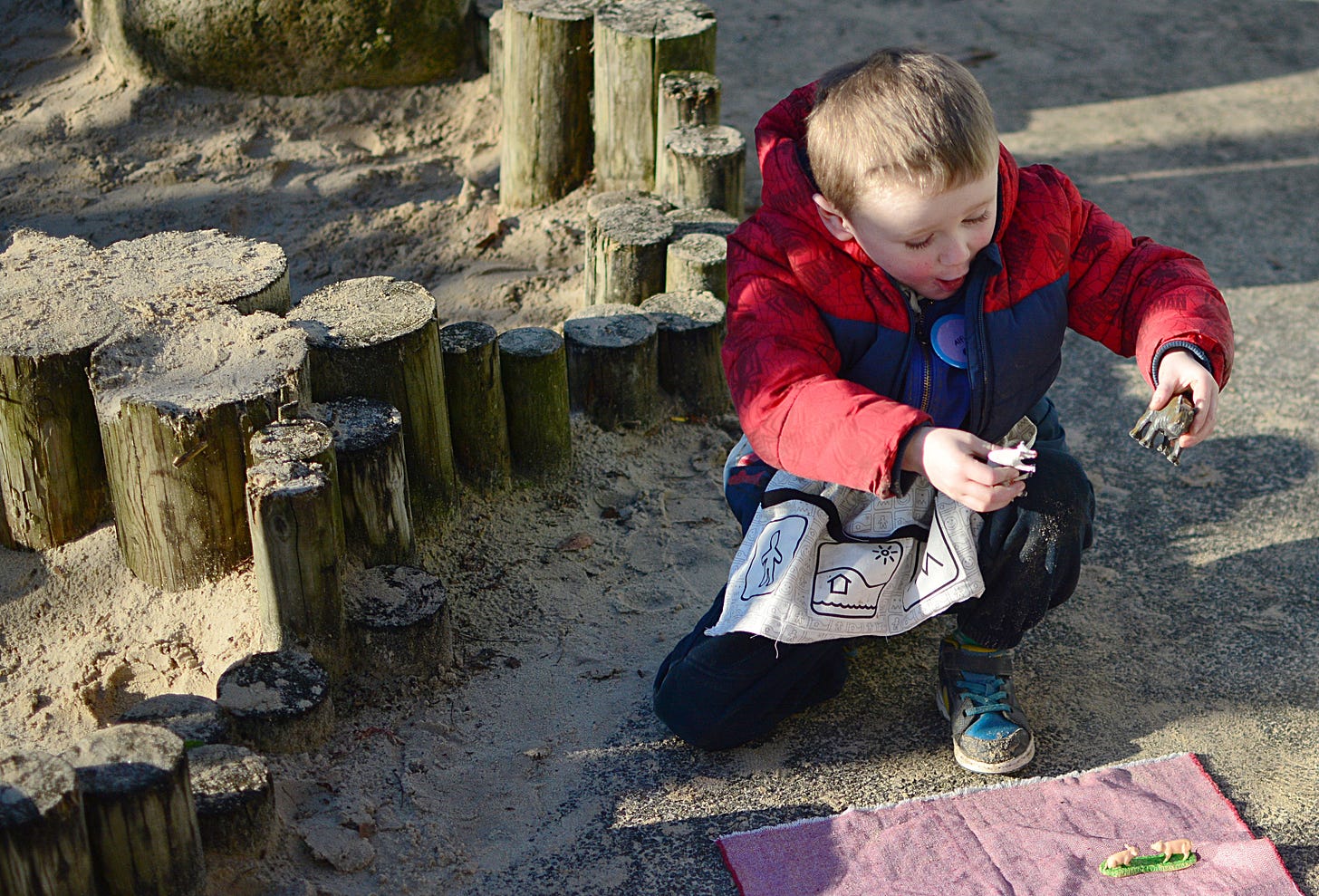Showing Children The Power of Possibility - From Tales Toolkit
Storytelling for Change - From Tales Toolkit
Happy Weekend PLAY People,
This month on the PLAYlist, we’ve got a fantastic guest article from Kate at Tales Toolkit called “Showing Children the Power of Possibility”—and it’s all about the messy, magical, made-up-on-the-spot kind of storytelling that children do so well (yes, including tales of Spiderman visiting Poo Poo Land). Kate explores how child-led storytelling supports language, imagination, emotional development and even hope, reminding us that when we make space for children’s stories, we’re really saying, “Your voice matters.” It’s packed with research and real warmth, and I think it’s one of those pieces that’ll stay with you long after you’ve read it.
Showing Children the Power of Possibility.
By Kate From Tales Toolkit
If you follow Alistair, then you probably have a strong belief in the magic of sharing a book with a child. You’ve seen how a story can open up and demystify the world while also transporting and firing imagination. I’m sure books are prominent in your provision. But what about storytelling? What about our abilities to spin a great yarn, tell tales around the fire, the ancient practice of just making stuff up.
We hear and tell stories all the time—in books, TV, music. Stories also sell us things: from cosmetics to political policies. Concepts like nationhood and democracy rely on shared stories. History teaches through story, philosophy uses it to explain ideas, and our economies hinge on predictions based on ongoing narrative.
A unique human trait is our ability to gossip — to talk about people, events, and issues beyond the here and now. It helps us bond, share concerns, and take action. We can respond to news of a tiger attacking a neighbouring tribe; we can find out why Marcus from accounts was crying and support him over a drink. Storytelling is genuinely our superpower, and right now billionaire-funded AI models are crawling the internet consuming our stories in order to emulate us. Our stories literally are us.
Storytelling and Connection
At the base of storytelling is connection. Storyteller(s) <-> audience. When you give time in your setting to encourage children’s stories you’re saying to those children ‘I’m listening.’ Storytelling is a safe space where all ideas are valued and creativity is encouraged. If the tale is going to be about Spiderman and his trip to Poo Poo Land,™ then go with the flow!
Shared story creation is a back-and-forth interaction founded in sustained shared thinking. When we create together, we serve and return, like in good conversations or the famous improv game of ‘yes and…’
We know that playful interactions facilitate meaningful learning, as well as allowing for greater creativity and flexibility in ideas and problem-solving (Hirsh-Pasek et al., 2009). There is a wealth of evidence to support the impact of sustained shared thinking on academic and socio-emotional development (e.g. Nutbrown et al., 2005; Melhuish et al., 2008). Children from disadvantaged backgrounds particularly benefit from quality interactions in their early years (Sheffield Morris et al., 2017).
Also, this sort of collaborative storytelling is fun! Be playful! Add voices with different accents and tone; use props, movement and song. Use story as a scaffold to expand on, act out and bring the children’s interests to life.
Storytelling and Communication, and Language.
Storytelling and imaginary play are valuable strategies for the development of spoken language and literacy within early years (Cremin et al., 2017), but in an environment with top-down pressure and expectations, literacy development is often driven by a focus on phonics. Children’s own stories can be neglected.
Rooting activity in the stories told by children can contribute to the development of a shared classroom climate where children are valued for the narratives and strengths that they can demonstrate in these sessions (Nicolopoulou & Richer, 2004). Differences in culture, language and cognitive ability are easily included. Plus you can include props that support the children you are playing with, pulling on their interests and needs: favourite toys and characters, sensory props like bubbles and light toys, etc.
Your provision can provide wonderful opportunities for all sorts of imaginative tales – sandpit fairytale castles, construction area rocketships, small world police chases. But make sure to also add in the familiar. Use children’s mini-mes so they can act in their own stories, find ‘Setting’ props to represent local areas and source ite ms they recognise from home.
If you have provision set up for play then I’m pretty sure you’ll hear children already engaging in all sorts of imaginative storytelling already. This combination of story, imagination, props and movement, along with adult scaffolding and sustained shared thinking… That’s going to make a huge difference for the vocabulary, speech, language and communication of your children.
Storytelling and Social and Emotional Development
When you give children the power to create their own stories you give them autonomy.
Dr. Rudine Sims Bishop describes story representation through “mirrors, windows, and sliding glass doors.”
Mirrors let children see themselves.
Windows offer views into other worlds.
Sliding glass doors let children step into and engage with those worlds.
When you create your own stories there’s no limit to the perspectives. Characters from different communities can be represented and used in many different ways: they can be brave, scared, curious, loud, quiet. They can take up different roles, the ‘Character’ this week can become the ‘Problem’ the next. You can retell a story from the baddy’s POV. Stories are empathy machines.
Making and changing stories gives children the belief they have the power to create, change and adapt their own story, perhaps even imparting a belief in a better tomorrow, a future that’s theirs to shape and design.
Storytelling and Literacy
When you give children the language, communication skills and confidence to tell their own story, literacy naturally follows.
Storytelling is such a powerful tool for literacy. A way to teach vocab and early phonics through sounds, rhyme, song, alliteration. It builds understanding and imagination, helping children read between the lines and think creatively.
When children feel they have a story to tell, the next move into writing that story and seeing themselves as an author isn’t such a big jump. Engagement and motivation with writing (which is over half the battle) rise when children are able to tell stories about the things that matter to them. Give them a chance to role-play their story and tell it orally first, before giving them pen and paper, so they’re already full of ideas and confidence.
Storytelling and Hope
Research shows that hope is formed in the lives of children when they are connected to adults who believe in them and teach them to mentally time travel (Irish, L. 2014). By guiding children to tell stories about what’s ahead, we give them the tools to shape who they are and who they might become.
After all, what are our identities, if not the stories we choose to tell about ourselves?
Let’s help children become the authors of their own future, filled with possibility, purpose, and hope.
Bibliography
Mirrors, windows, and sliding glass doors. Perspectives: Choosing and Using Books for the Classroom, 6 (3) RS Bishop - Perspectives: Choosing and using books for the …, 1990
https://www.google.com/url?q=https://speechandlanguage.org.uk/wp-content/uploads/2024/08/Getting-in-early-report-FINAL.pdf?utm_source%3Dchatgpt.com&sa=D&source=docs&ust=1744627284792395&usg=AOvVaw0afEOxMkuPWOU_vtqZINY8
Hirsh-Pasek, K. (2009). A Mandate for Playful Learning in Preschool: Applying the Scientific Evidence. United Kingdom: Oxford University Press, USA.
Cremin, Teresa; Flewitt, Rosie; Mardell, Ben and Swann, Joan eds. (2016). Storytelling in Early Childhood: Enriching language, literacy, and classroom culture. London and New York: Routledge.
Ageliki Nicolopoulou. (2011). Children’s Storytelling: Toward an Interpretive and Sociocultural Approach. Storyworlds: A Journal of Narrative Studies, 3, 25–48. https://doi.org/10.5250/storyworlds.3.2011.0025
Melhuish et al.,(2008). Journal of Social Issues, https://doi.org/10.1111/j.1540-4560.2008.00550.x
Nutbrown et al.,(2005). Early literacy work with families. SAGE Publications.
Sheffield Morris(2017). Child Development, https://doi.org/10.1111/cdev.12743










